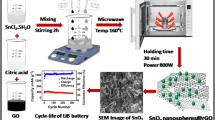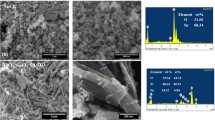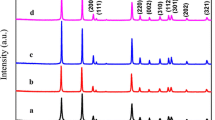Abstract
Surfactant and organic solvents-based SnO2 rods and SnO2/rGO, SnO2/MWCNTs composite materials were synthesized by microwave-assisted hydrothermal process. Powder X-ray diffraction analysis revealed the rutile phase formation. Surface morphology of the prepared samples and their chemical compositions were investigated by SEM and EDS, respectively. Lithium ion batteries (LIBs) were fabricated from synthesized SnO2 rods and composites SnO2/rGO, SnO2/MWCNTs as anode materials and it revealed promising initial discharge capacity of 1426 mAh g−1 and 1575 mAh g−1, 1189 mAh g−1 respectively. Electrochemical studies showed that the discharge capacities retained even after 100th cycle were found to be 171 mAh g−1, 351 mAh g−1 and 214 mAh g−1 even at a high current density of 500 mA g−1, with high coulombic efficiency for SnO2 rods and SnO2/rGO, SnO2/MWCNTs composites, respectively. These findings are better than the commercially used graphite as anode material. Further, electrochemical impedance spectra of the fabricated LIBs having SnO2/rGO and SnO2/MWCNTs composites used as anode material showed less charge transfer resistance as compared to bare SnO2 rods. Due to low charge transfer resistance, improved electrical conductivity and the large surface area of rGO nanosheets, the SnO2/rGO composite exhibited better electrochemical performance when compared with the bare SnO2 rods and SnO2/MWCNTs composite.






Similar content being viewed by others
References
M. Winter, R.J. Brodd, What are batteries, fuel cells, and supercapacitors. Chem. Rev. 104, 4245–4270 (2004)
A.L. Mohana Reddy, S.R. Gowda, M.M. Shaijumon, P.M. Ajayan, Hybrid nanostructures for energy storage applications. Adv. Mat. 24, 5045–5064 (2012)
Z.-S. Wu, G. Zhou, L.-C. Yin, W. Ren, F. Li, H.-M. Cheng, Graphene/metal oxide composite electrode materials for energy storage. Nano Energy 1, 107–131 (2012)
B. Luo, S. Liu, L. Zhi, Chemical approaches toward graphene-based nanomaterials and their applications in energy-related areas. Small 8, 630–646 (2012)
Y. Idota, T. Kubota, A. Matsufuji, Y. Maekawa, T. Miyasaka, Tin-based amorphous oxide: a high-capacity lithium-ion-storage. Mater. Sci. 276, 1395–1397 (1997)
J.M. Tarascon, M. Armand, Issues and challenges facing rechargeable lithium batteries. Nature 414, 359–367 (2001)
P. Poizot, S. Laruelle, S. Grugeon, L. Dupont, J.M. Tarascon, Nano-sized transition-metaloxides as negative-electrode materials for lithium-ion batteries. Nature 407, 496–499 (2000)
X. Wu, Z. Wang, M. Yu, L. Xiu, J. Qiu, Stabilizing the MXenes by carbon nanoplating for developing hierarchical nano-hybrids with efficient lithium storage and hydrogen evolution capability. Adv. Mater. 29, 1–8 (2017)
Y. Dong, M. Yu, Z. Wang, Y. Liu, X. Wang, Z. Zhao, J. Qiu, A top-down strategy toward 3D carbon nano sheet frame works decorated with hollow nanostructures for superior lithium storage. Adv. Funct. Mater. 26, 7590–7598 (2016)
Z.H. Li, T.P. Zhao, X.Y. Zhan, D.S. Gao, Q.Z. Xiao, G.T. Lei, High capacity three-dimensional ordered macroporous CoFe2O4 as anode material for lithium ion batteries. Electrochim. Acta 55, 4594–4598 (2010)
C. Yuan, H.B. Wu, Y. Xie, X.W. David Lou, Mixed transition-metal oxides: design, synthesis, and energy-related applications. Angew. Chem. Int. Ed. 53, 1488–1504 (2014)
F.M. Courtel, H. Duncan, Y. Abu-Lebdeh, I.J. Davidson, High capacity anode materials for Li-ion batteries based on spinel metal oxides AMn2O4 (A = Co, Ni, and Zn). J. Mater. Chem. 21, 10206–10218 (2011)
P. Lavela, J.L. Tirado, CoFe2O4 and NiFe2O4 synthesized by sol–gel procedures for their use as anode materials for Li ion batteries. J. Power Sources 172, 379–387 (2007)
B.Y. Sharma, N. Sharma, G.V. Subba Rao, B.V.R. Chowdari, Nanophase ZnCo2O4 as a high performance anode material for Li-Ion batteries. Adv. Funct. Mater. 17, 2855–2861 (2007)
M.T. Demko et al., Mechanical homogenization of antimony, iron oxide, and carbon black composites for use in lithium ion batteries. Mater. Chem. Phys. 224, 376–383 (2019)
X. Han, X. Han, L. Sun, P. Wang, M. Jin, X.-J. Wang, Facile preparation of hybrid anatase/rutile TiO2 nanorods with exposed (010) facets for lithium ion batteries. Mater. Chem. Phys. 171, 11–15 (2016)
L. Zhang, H.B. Wu, X.W. David Lou, Iron-oxide-based advanced anode materials for lithium-ion batteries. Adv. Energy Mater. 4, 1300958–1300966 (2014)
N. Naresh, P. Jena, N. Satyanarayana, Facile synthesis of MoO3/rGO nanocomposite as anode materials for high performance lithium-ion battery applications. J. Alloys Compd. 810, 151920–151927 (2019)
H. Zhang, X. Yu, P.V. Braun, Three-dimensional bicontinuous ultrafast-charge and discharge bulk battery electrodes. Nat. Nanotechnol. 6, 277–281 (2011)
H.B. Wu, J.S. Chen, H.H. Hng, X.W. David Lou, Nanostructured metal oxide-based materials as advanced anodes for lithium-ion batteries. Nanoscale 4, 2526–2542 (2012)
S. Yang, W. Yue, J. Zhu, Y. Ren, X. Yang, Graphene-based mesoporous SnO2 with enhanced electrochemical performance for lithium-ion batteries. Adv. Funct. Mater. 23, 3570–3576 (2013)
X. Wang, X. Zhou, K. Yao, J. Zhang, Z. Liu, A SnO2/graphene composite as a high stability electrode for lithium ion batteries. Carbon 49, 133–139 (2011)
J.S. Chen, X.W. Lou, SnO2-based nanomaterials: synthesis and application in lithium-ion batteries. Small 9, 1877–1893 (2013)
Z. Li, G. Wu, S. Deng, S. Wang, Y. Wang, J. Zhou, S. Liu, W. Wu, M. Wu, Combination of uniform SnO2 nanocrystals with nitrogen doped graphene for high-performance lithium-ion batteries anode. Chem. Eng. J. 283, 1435–1442 (2016)
J. Ning, T. Jiang, K. Men, Q. Dai, D. Li, Y. Wei, B. Liu, G. Chen, B. Zou, G. Zou, Synthesis, characterizations, and applications in lithium ion batteries of hierarchical SnO2 nanocrystals. J. Phys. Chem. C 113, 14140–14144 (2009)
X. Ye, W. Zhang, Q. Liu, S. Wang, Y. Yang, H. Wei, One-step synthesis of Ni-doped SnO2nanospheres with enhanced lithium ion storage performance. New J. Chem. 39, 130–136 (2014)
D.V. Szabo, G. Kilibarda, S. Schlabach, V. Trouillet, M. Bruns, Structural and chemical characterization of SnO2-based nanoparticles as electrode material in Li-ion batteries. J. Mater. Sci. 47, 4383 (2012)
H. Kim et al., New insight into the reaction mechanism for exceptional capacity of ordered mesoporous SnO2 electrodes via synchrotron-based X-ray analysis. Chem. Mater. 26, 6361–6370 (2014)
Y. Deng, C. Fang, G. Chen, The developments of SnO2/graphene nanocomposites as anode materials for high performance lithium ion batteries: a review. J. Power Sources 304, 81–101 (2016)
J.Y. Huang, L. Zhong, C.M. Wang, J.P. Sullivan, W. Xu, L.Q. Zhang, S.X. Mao, N.S. Hudak, X.H. Liu, A. Subramanian, H.Y. Fan, L. Qi, A. Kushima, J. Li, In situ observation of the electrochemical lithiation of a single SnO2 nanowire electrode. Science 330, 1515–1520 (2010)
J. Lin, Z. Peng, C. Xiang, G. Ruan, Z. Yan, D. Natelson, J.M. Tour, Graphene nanoribbon and nanostructured SnO2 composite anodes for lithium ion batteries. ACS Nano 7, 6001–6006 (2013)
C. Zhong, J. Wang, Z. Chen, H. Liu, SnO2–graphene composite synthesized via an ultrafast and environmentally friendly microwave autoclave method and its use as a superior anode for lithium-ion batteries. J. Phys. Chem. C 115, 25115–25120 (2011)
J. Cui, S. Yao, J.-Q. Huang, L. Qin, W.G. Chong, Z. Sadighi, J. Huang, Z. Wang, J.-K. Kim, Sb-doped SnO2/graphene-CNT aerogels for high performance Li-ion and Na-ion battery anodes. Energy Storage Mater. 9, 85–95 (2017)
Y. Dong, S. Liu, Y. Liu, Y. Tang, T. Yang, X. Wang, Z. Wang, Z. Zhao, J. Qiu, Rational design of metal oxide hollow nanostructures decorated carbon nanosheets for superior lithium storage. J. Mater. Chem. A 4, 17718–17725 (2016)
S. Jiang, W. Yue, Z. Gao, Y. Ren, H. Ma, X. Zhao, Y. Liu, X. Yang, Graphene-encapsulated mesoporous SnO2 composites as high performance anodes for lithium-ion batteries. J. Mater. Sci. 48, 3870–3876 (2013)
Y. Wang, D.W. Su, C.Y. Wang, G.X. Wang, SnO2@MWCNT nanocomposite as a high capacity anode material for sodium-ion batteries. Electrochem. Commun. 29, 8–11 (2013)
M. OguzGuler, O. Cevher, T. Cetinkaya, U. Tocoglu, H. Akbulut, Nanocomposite anodes for lithium-ion batteries based on SnO2 on multiwalled carbon nanotubes. Int. J. Energy Res. 38, 487–498 (2014)
Y. Fu, R. Ma, Y. Shu, Z. Cao, X. Ma, Preparation and characterization of SnO2/carbon nanotube composite for lithium ion battery applications. Mater. Lett. 63, 1946–1948 (2009)
B.M.-S. Park, Y.-M. Kang, G.-X. Wang, S.-X. Dou, H.-K. Liu, The effect of morphological modification on the electrochemical properties of SnO2 nanomaterials. Adv. Funct. Mater. 18, 455–461 (2008)
J. Ye, H. Zhang, R. Yang, X. Li, L. Qi, Morphology-controlled synthesis of SnO2 nanotubes by using 1D silica mesostructures as sacrificial templates and their applications in lithium-ion batteries. Small 6, 296–306 (2010)
H.-Q. Wang, G.-H. Yang, Y.-G. Huang, X.-H. Zhang, Z.-X. Yan, Q.-Y. Li, Electrochemical performance of SnO2/modified graphite composite material as anode of lithium ion battery. Mater. Chem. Phys. 167, 303–308 (2015)
Z.W. Pan, Z.R. Dai, Z.L. Wang, Nanobelts of semiconducting oxides. Science 291, 1947–1949 (2001)
O. Lupan, L. Chow, G. Chai, H. Heinrich, S. Park, A. Schulte, Growth of tetragonal SnO2 microcubes and their characterization. J. Cryst. Growth 311, 152–155 (2008)
Z. Liu, D. Zhang, S. Han, C. Li, T. Tang, W. Jin, X. Liu, B. Lei, C. Zhou, Laser ablation synthesis and electron transport studies of tin oxide nanowires. Adv. Mater. 15, 1754–1757 (2003)
O. Lupan, L. Chow, G. Chai, A. Schulte, S. Park, H. Heinrich, A rapid hydrothermal synthesis of rutile SnO2 nanowires. Mater. Sci. Eng. B 157, 101–104 (2009)
X. Xia, S. Li, X. Wang, J. Liu, Q. Wei, X. Zhang, Structures and properties of SnO2 nanofibers derived from two different polymer intermediates. J. Mater. Sci. 48, 3378–3385 (2013)
X. Huang, X. Zhou, L. Zhou, K. Qian, Y. Wang, Z. Liu, C. Yu, A facile one-step solvothermal synthesis of SnO2/graphene nanocomposite and its application as an anode material for lithium-ion batteries. Chem. Phys. Chem. 12(2), 278–281 (2011)
V. Subramanian, W.W. Burke, Z. Hongwei, W. Bingqing, Novel microwave synthesis of nanocrystalline SnO2 and its electrochemical properties. J. Phys. Chem. C 112, 4550–4556 (2008)
Y. Zhu, H. Guo, H. Zhai, C. Cao, Microwave-assisted and gram-scale synthesis of ultrathin SnO2 nanosheets with enhanced lithium storage properties. ACS Appl. Mater. Interfaces 7, 2745–2753 (2015)
N. Naresh, D. Narsimulu, P. Jena, E.S. Srinadhu, N. Satyanarayana, Microwave-assisted hydrothermal synthesis of SnO2/reduced graphene-oxide nanocomposite as anode material for high performance lithium-ion batteries. J. Mater. Sci.: Mater. Electron. 29, 14723–14732 (2018)
B.D. Boruah, A. Misra, Polyethylenimine mediated reduced graphene oxide based flexible paper for supercapacitor. Energy Storage Mater. 5, 103–110 (2016)
N. Srinivasan, S. Mitra, R. Bandyopadhyaya, Improved electrochemical performance of SnO2–mesoporous carbon hybrid as a negative electrode for lithium ion battery applications. Phys. Chem. Chem. Phys. 16, 6630–6640 (2014)
J. Yue, W. Wang, N. Wang, X. Yang, J. Feng, J. Yang, Y. Qian, Triple-walled SnO2@ N-doped carbon@ SnO2 nanotubes as an advanced anode material for lithium and sodium storage. J. Mater. Chem. A 3, 23194–23200 (2015)
R. Demir-Cakan, Y.S. Hu, M. Antonietti, J. Maier, M.M. Titirici, Facile one-pot synthesis of mesoporous SnO2 microspheres via nanoparticles assembly and lithium storage properties. Chem. Mater. 20, 1227–1229 (2008)
Z. Huang, H. Gao, Q. Wang, Y. Zhao, G. Li, Fabrication of amorphous SnO2@C nanofibers as anode for lithium-ion batteries. Mater. Lett. 186, 231–234 (2017)
G. Xing, Y. Wang, J. Wong, Y. Shi, Z. Huang, S. Li, H. Yang, Hybrid CuO/SnO2 nanocomposites: towards cost-effective and high performance binder free lithium ion batteries anode materials. Appl. Phys. Lett. 105, 143905–143910 (2014)
X. Zhang, J. Liang, G. Gao, S. Ding, Z. Yang, W. Yu, B.Q. Li, The preparation of mesoporous SnO2 nanotubes by carbon nanofibers template and their lithium storage properties. Electrochim. Acta 98, 263–267 (2013)
H. Zhang, H. Song, X. Chen, J. Zhou, H. Zhang, Preparation and electrochemical performance of SnO2@carbon nanotube core–shell structure composites as anode material for lithium-ion batteries. Electrochim. Acta 59, 160–167 (2012)
J.Y. Eom, D.Y. Kim, H.S. Kwon, Effects of ball-milling on lithium insertion into multi-walled carbon nanotubes synthesized by thermal chemical vapour deposition. J. Power Sources 157, 507–514 (2006)
L. Hu, H. Zhong, X. Zheng, Y. Huang, P. Zhang, Q. Chen, CoMn2O4 spinel hierarchical microspheres assembled with porous nanosheets as stable anodes for lithium-ion batteries. Sci. Rep. 2, 986–993 (2012)
D. Zhou, W.L. Song, X. Li, L.Z. Fan, Hierarchical porous reduced graphene oxide/SnO2 networks as highly stable anodes for lithium-ion batteries. Electrochim. Acta 207, 9–15 (2016)
P. Wu, N. Du, H. Zhang, J. Yu, Y. Qi, D. Yang, Carbon-coated SnO2 nanotubes: template-engaged synthesis and their application in lithium-ion batteries. Nanoscale 3, 746–750 (2011)
C. Xu, J. Sun, L. Gao, Direct growth of monodisperse SnO2 nanorods on graphene as high capacity anode materials for lithium ion batteries. J. Mater. Chem. 22, 975–979 (2012)
C. Li, W. Wei, S. Fang, H. Wang, Y. Zhang, Y. Gui, R. Chen, A novel CuO nanotube/SnO2 composite as the anode material for lithium ion Batteries. J. Power Sources 195, 2939–2944 (2010)
M. Zhang, D. Lei, Z. Du, X. Yin, L. Chen, Q. Li, Y. Wang, T. Wang, Fast synthesis of SnO2/graphene composites by reducing graphene oxide with stannous ions. J. Mater. Chem. 21, 1673–1676 (2011)
D. Wang, X. Li, J. Wang, J. Yang, D. Geng, R. Li, M. Cai, T. Sham, X. Sun, Defect-rich crystalline SnO2 immobilized on graphene nanosheets with enhanced cycle performance for Li ion batteries. J. Phys. Chem. C 116, 22149–22156 (2012)
H. Qiao, Z. Zheng, L. Zhang, L. Xiao, SnO2@C core-shellspheres: synthesis, characterization, and performance in reversible Li-ion storage. J. Mater. Sci. 43, 2778–27784 (2008)
Acknowledgements
This work is financially supported by the Odisha Higher Education Program for Excellence and Equity (OHEPEE), Higher Education Department, Government of Odisha, INDIA, Assisted by World Bank. NS gratefully acknowledges UGC, Govt. of INDIA for awarding BSR Faculty fellowship: No. F.18-1/2011(BSR), Date: 07-03-2019.
Author information
Authors and Affiliations
Corresponding authors
Ethics declarations
Conflict of interest
The authors declare that they have no conflict of interest.
Additional information
Publisher's Note
Springer Nature remains neutral with regard to jurisdictional claims in published maps and institutional affiliations.
Rights and permissions
About this article
Cite this article
Jena, P., Naresh, N., Satyanarayana, N. et al. Electrochemical performance of SnO2 rods and SnO2/rGO, SnO2/MWCNTs composite materials as an anode for lithium-ion battery application-A comparative study. J Mater Sci: Mater Electron 32, 7619–7629 (2021). https://doi.org/10.1007/s10854-021-05478-5
Received:
Accepted:
Published:
Issue Date:
DOI: https://doi.org/10.1007/s10854-021-05478-5




